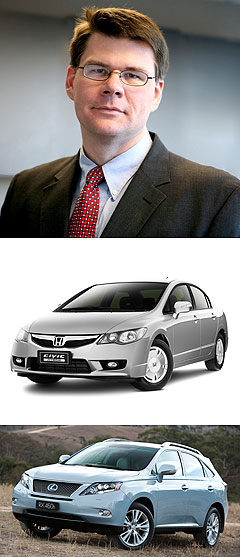Market Insight: Study finds inherent safety in hybrids
BY TERRY MARTIN | 25th Nov 2011

The unique analysis compared data relating to car collision and personal injury claims over an eight-year period for more than 25 hybrid and equivalent conventional models, including the Honda Civic, Toyota Camry and Lexus RX, GS and LS models – pairings that are also offered in Australia.
While it did not examine dedicated hybrids such as Toyota’s Prius, Honda’s Insight and just-launched CR-Z and Holden’s forthcoming plug-in Volt (which this week scored a five-star safety rating from Euro NCAP), the study’s conclusion that hybrid drivers and their passengers have much lower odds of being injured in a crash – due largely to the extra mass of the vehicle – lends weight to the entire hybrid car cause.
Hybrids still only account for a fraction of total new-vehicle sales in Australia and have actually declined in popularity this year, despite redesigned and all-new models entering the marketplace.
VFACTS figures show that to the end of October, just 7201 new hybrids were registered – 456 down on the same point last year, and a drop in the ocean compared to the industry’s total of 837,324 new vehicle sales YTD.

An affiliate of the authoritative US Insurance Institute for Highway Safety, the HLDI says its findings are “more good news” for any consumers under the impression that a trade-off in safety is required to obtain a vehicle offering superior fuel economy – that is, downsizing to a smaller and lighter vehicle.
“Saving at the pump no longer means you have to skimp on crash protection,” said HLDI vice-president and author of the report, Matt Moore.
The study analysed vehicle collision claims and related injury claims filed in the US between 2002 and 2010 under personal injury protection (PIP) – which covers occupants’ medical expenses, no matter who is at fault – or medical payment (MedPay) coverage, which covers occupants’ treatment costs when the driver is at fault.
The vehicles covered the 2003-11 model years, with 26 series pairs meeting the criteria in the collision/PIP analysis and 27 pairs for collision/MedPay.
Vehicle specifics such as kerb weight formed part of the analysis – hybrids were heavier across the board, ranging from three to 16 per cent – and other variables such as incident date, driver age, gender and marital status, and, also for the vehicle, the age, series, garaging state and density (number of registered vehicles per square mile).
With this information, HLDI estimated the odds that a crash would result in injuries if people were occupants in a hybrid versus the conventional version of the same vehicle.
Significantly, it found the odds of injury in a hybrid were 26.5 per cent lower than in their conventional-engine counterparts for collisions with a related PIP claim, and 25.3 per cent lower for collision claims with a related MedPay claim.
The HLDI concluded that, in particular, the extra mass of hybrid variants gave them a safety advantage over equivalent conventional-engine models.
Although they have the same footprint and structure, hybrids tend to outweigh their stablemates with the added heft of battery packs and other components used in dual-power systems.
“Weight is a big factor,” Mr Moore said. “Hybrids on average are 10 per cent heavier than their standard counterparts. This extra mass gives them an advantage in crashes that their conventional twins don’t have.”The HLDI says the results of the study are encouraging from both an energy and environmental standpoint, with the use of hybrid vehicles reducing fuel consumption and emissions while simultaneously improving safety.
However, in a separate study, the HLDI also found that hybrids – which have an ever-increasing electric-only driving range – may be as much as 20 per cent more likely to be involved in pedestrian crashes with injuries than their conventional counterparts.
The institute examined how frequently injury claims were filed for 17 hybrids and their non-hybrid counterparts when there was no related collision or property damage.
Studied vehicles included 2002-2010 full hybrid models and their standard twins during 2004-2010 calendar years, totalling 25,382 bodily injury liability claims that cover medical, hospital and other expenses for injuries that at-fault drivers inflict on occupants of other vehicles or others on the road.
“When hybrids operate in electric-only mode pedestrians can’t hear them approaching,” said Mr Moore. “So they might step out into the roadway without checking first to see what’s coming.”The US National Highway Traffic Safety Administration (NHTSA) is currently working within a three-year timeframe to come up with a standard for equipping hybrids and electric vehicles with sounds to alert unsuspecting pedestrians.
Most manufacturers are already working on the problem, such as Nissan building an ‘approaching vehicle sound’ into its forthcoming Leaf EV that kicks in when driving at certain speeds.